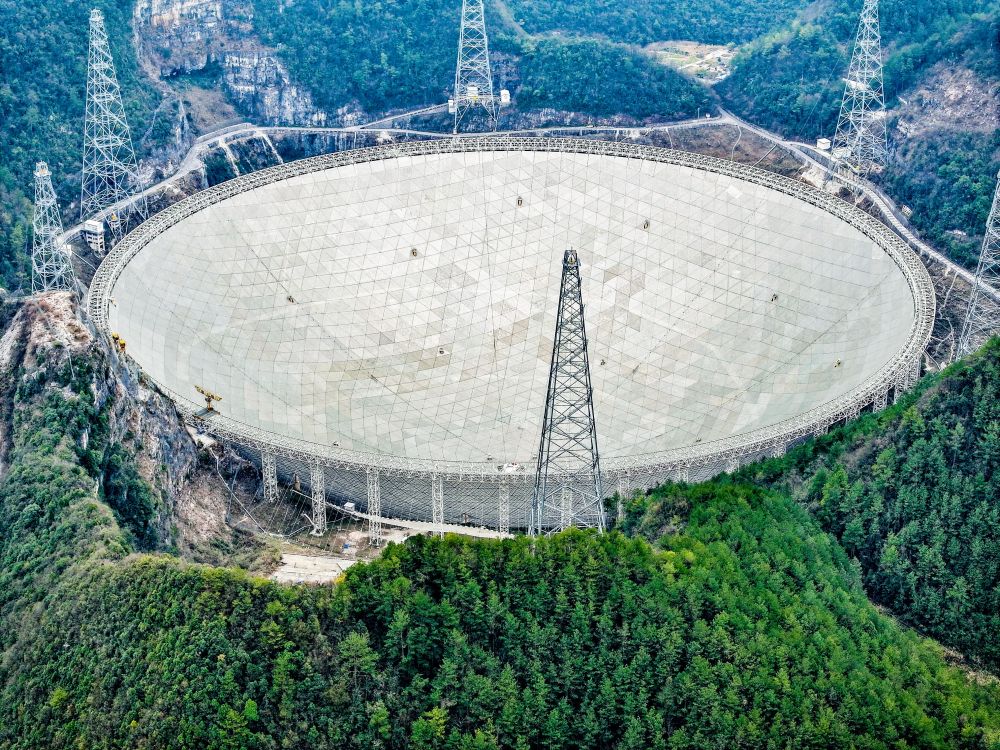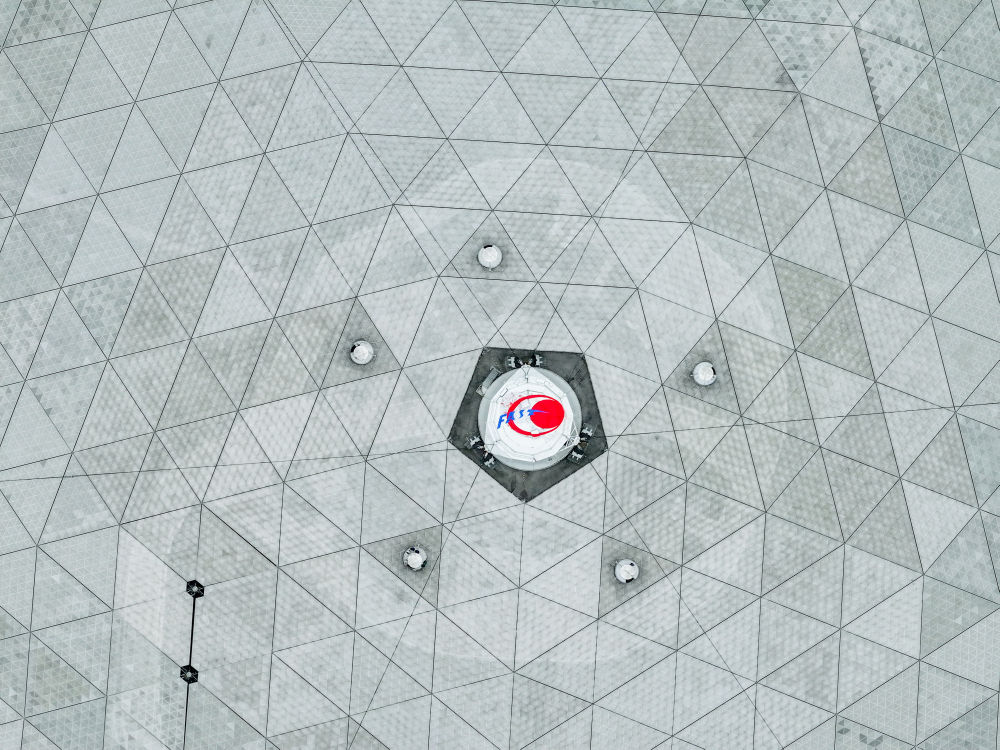Starry sky keeps walking-"Five-hundred-meter Aperture Spherical Radio Telescope (FAST)" provides "China wisdom" for world astronomy.

On April 17th, the reporter learned from the FAST Operation and Development Center of the National Astronomical Observatory that more than 900 new pulsars have been discovered by the 500-meter spherical radio telescope (FAST) known as the "Five-hundred-meter Aperture Spherical Radio Telescope (FAST)".
Produce a series of world-class achievements in the fields of the origin of fast radio bursts and gravitational wave detection; Independent research and development of receiver core components is expected to go abroad; FAST core array construction is ready to go … …
Staring at the starry sky, I kept walking. "Five-hundred-meter Aperture Spherical Radio Telescope (FAST)" is constantly providing China wisdom to the world astronomy and China technology to the global engineering community.

Frequent achievements
"Five-hundred-meter Aperture Spherical Radio Telescope (FAST)" is a well-known national weapon. In order to "produce early results, produce more results, produce good results and produce great results", China scientists constantly "challenge the limits of cognition and technology" and polish their profound "eyes" with "Creation by China".

On April 17th, the reporter got news from the FAST Operation and Development Center of the National Astronomical Observatory of the Chinese Academy of Sciences that the number of new pulsars discovered by the 500-meter spherical radio telescope (FAST), known as the "Five-hundred-meter Aperture Spherical Radio Telescope (FAST)", exceeded 900. Xinhua News Agency issued Liu Xu Lu Yuhan’s establishment
Up to now, Five-hundred-meter Aperture Spherical Radio Telescope (FAST) has discovered more than 900 new pulsars, including at least 170 millisecond pulsars, 120 binary pulsars and 80 faint occasional pulsars.
"We are expanding the cognitive limits of human beings to the universe." Han Jinlin, head of the galactic plane Pulsar Survey Project of the National Astronomical Observatory, said. In the 50 years from the discovery of the first pulsar by humans to the discovery of the first pulsar by FAST, less than 3,000 pulsars have been discovered in the world.
On October 10th, 2017, Five-hundred-meter Aperture Spherical Radio Telescope (FAST) announced the discovery of six new pulsars, achieving a "zero breakthrough". This is the first time that China has discovered pulsars with its own independently developed radio telescope.
At present, more than 900 new pulsars have been discovered by Five-hundred-meter Aperture Spherical Radio Telescope (FAST), which is more than three times the total number of pulsars discovered by other telescopes at the same time in the world.
Among them, compared with the normal pulsars, the radiation flux density of 80 faint occasional pulsars is one order of magnitude lower, and the lowest one has reached the submicrocentric order.
In Han Jinlin’s view, the study of these accidental pulsars is of great significance for understanding how many dense neutron star wrecks are formed after the death of stars in the Milky Way and revealing the unknown physical process of pulse radiation.
Han Jinlin told reporters that if searching for pulsars is compared to picking fruits, all the pulsars discovered before are close to the ground and easy to "pick", while the more than 900 new pulsars discovered by Five-hundred-meter Aperture Spherical Radio Telescope (FAST) are farther away or more difficult to pick.
Because each pulsar has its own special pulse and stable rotation frequency, they are equivalent to the "lighthouse" with unique signal marks in the universe. If the Interstellar can be realized in the future, these pulsars will provide "navigation" for human beings to travel in the vast universe.
"We accurately measure the coordinates of pulsars in space, and monitor the phases and corresponding positional relationships of multiple pulsar signals during the journey, so that humans will not get lost in interstellar travel." Han Jinlin said.

Panorama of "Five-hundred-meter Aperture Spherical Radio Telescope (FAST)" taken on February 26th, 2024 (panoramic picture of UAV, taken during maintenance). Xinhua News Agency reporter Ou Dongyu photo
It is the first time to observe the "pulse" of black hole in radio band, detect the key evidence of the existence of nanohertz gravitational wave, and detect and construct the world’s largest neutral hydrogen galaxy sample … … In recent years, "Five-hundred-meter Aperture Spherical Radio Telescope (FAST)" has made China contributions to exploring the mysteries of the universe.
In the face of the unknown and the future, human destiny is shared. From the moment it was born, "Five-hundred-meter Aperture Spherical Radio Telescope (FAST)" shouldered the mission.
Sun Chun, the measurement and control engineer of Five-hundred-meter Aperture Spherical Radio Telescope (FAST), introduced that since it was officially opened to the global scientific community on March 31st, 2021, Five-hundred-meter Aperture Spherical Radio Telescope (FAST) has helped research teams from 15 countries including the United States, the Netherlands and Australia to carry out observation for nearly 900 hours, covering many fields such as scientific target drift scanning survey, neutral hydrogen galaxy survey, galaxy polarization survey, pulsar time measurement, and rapid radio burst observation.
In the foreseeable future, "Five-hundred-meter Aperture Spherical Radio Telescope (FAST)" will bring more new perspectives for the international astronomical community to continue to explore the universe and try to find the unknown, and make greater contributions to leading mankind to break through the new field of cognition.

Innovation is not limited.
"I thought it would be revised seven or eight times, but I didn’t expect the performance of the first edition to reach the world advanced level." Chai Xiaoming, a senior engineer at the National Astronomical Observatory of the Chinese Academy of Sciences, introduced to the reporter a low-noise amplifier with a silver-plated shell and only the size of an organ. It was hard to hide his excitement in his speech.
Low noise amplifier is the core component of Five-hundred-meter Aperture Spherical Radio Telescope (FAST) receiver, which was imported before.
In order to solve the problem of "stuck neck" and master the key technology in their own hands, Chai Xiaoming’s team spent nearly two years independently developing this high-performance domestic low-noise amplifier.

Panorama of "Five-hundred-meter Aperture Spherical Radio Telescope (FAST)" taken on February 26th, 2024 (panoramic picture of UAV, taken during maintenance). Xinhua News Agency reporter Ou Dongyu photo
Once the prototype was launched, it attracted the attention of the international astronomical community. The BINGO project in Brazil first proposed the willingness to cooperate in bulk purchase to the FAST Operation and Development Center.
As the largest and most sensitive single-aperture spherical radio telescope in the world, "Five-hundred-meter Aperture Spherical Radio Telescope (FAST)" has stimulated many special technical requirements, which requires China scientists to give full play to their subjective initiative and creativity, and to optimize and upgrade by constantly "challenging the cognitive and technical limits" and constantly "discovering and solving problems".
There is no shortcut to innovation, only dare to climb.
"No one told you what to do, and no one was sure that his own method would work." Jiang Peng, executive deputy director and chief engineer of FAST Operation and Development Center, said that the difficult research of "trial and error, failure and courage" runs through almost every link of FAST construction stage.
In order to solve the problem of cable fatigue, Jiang Peng led a group of young people through nearly 100 failures and successfully supported the "retina" of "Five-hundred-meter Aperture Spherical Radio Telescope (FAST)".

The "Five-hundred-meter Aperture Spherical Radio Telescope (FAST)" feed cabin (photo of UAV, taken during maintenance) taken on February 26th, 2024. Xinhua News Agency reporter Ou Dongyu photo
In order to develop a new control system, Sun Jinghai, director of the Measurement and Control Engineering Department of FAST Operation and Development Center, burned the midnight oil to the east for countless times and almost rewritten all the core algorithm codes.
In order to solve the problem of electromagnetic interference in substations, Gan Hengqian, director of the Electronic and Electrical Engineering Department of FAST Operation and Development Center, invented &hellip, a high-voltage filter matching with Five-hundred-meter Aperture Spherical Radio Telescope (FAST), after nearly two years of exploration and testing. …
Only in the construction stage, "Five-hundred-meter Aperture Spherical Radio Telescope (FAST)" won important scientific and technological awards in more than ten fields, such as steel structure, automation industry, machinery industry, surveying and mapping geographic information technology, and electromagnetic compatibility research and development.

Panorama of "Five-hundred-meter Aperture Spherical Radio Telescope (FAST)" taken on February 26th, 2024 (photo of UAV, taken during maintenance). Xinhua News Agency reporter Ou Dongyu photo
"Eye of the Sky" asks the sky, and there is no end. Jiang Peng said frankly that if FAST is only regarded as a telescope and a monitoring device, it has reached the standard now. However, to maintain the leading position of FAST in the world, our innovation cannot stop, and we will do our best to make FAST more stable and efficient.
At present, the annual observation time of FAST is stable at about 5,300 hours, which plays an important supporting role in continuously outputting scientific research results.

Compete for the future
Explore the sky and decipher the stars. "Five-hundred-meter Aperture Spherical Radio Telescope (FAST)" has never stopped innovating.
"Astronomy is extremely romantic, because it studies the sea of stars of human beings. Astronomy is also extremely cruel, because international competition is extremely fierce, and once it is relaxed, it will lose its leading position. " Jiang Peng said.
Looking around the world, many radio telescope arrays, such as SKA, are under construction.

Five-hundred-meter Aperture Spherical Radio Telescope (FAST) measuring pier photographed by infrared camera on February 27th, 2024 (photographed during maintenance). Xinhua News Agency reporter Ou Dongyu photo
"Once these telescopes are put into operation, ‘ Five-hundred-meter Aperture Spherical Radio Telescope (FAST) ’ Will face enormous challenges. " Jiang Peng said, "If we relax a little, China astronomers may ‘ Lost ’ The forefront of the radio band field of vision. "
The reporter recently walked into the core area of "Five-hundred-meter Aperture Spherical Radio Telescope (FAST)" and saw on a hill less than 3 kilometers away from "Five-hundred-meter Aperture Spherical Radio Telescope (FAST)" that the excavator was working intensively, and the original jagged hill top with miscellaneous trees had been leveled and compacted.
"We plan to use the excellent electromagnetic wave environment within 5 kilometers around FAST in the next five years to build 20 to 30 fully movable radio telescopes with a diameter of 40 meters, and form a comprehensive aperture array with FAST, that is, the FAST core array." Jiang Peng told reporters that a 40-meter-class fully movable radio telescope will be built on the working hill within this year.
"By ‘ Five-hundred-meter Aperture Spherical Radio Telescope (FAST) ’ Observing the universe is like using ‘ Thick-headed pencil ’ If the core array is completed and put into use, it is equivalent to using high-resolution ‘ Digital camera ’ Shoot the distant stars. " Jiang Peng introduced that once the core array is completed, it will greatly improve the vision of "Five-hundred-meter Aperture Spherical Radio Telescope (FAST)" and let "‘ Five-hundred-meter Aperture Spherical Radio Telescope (FAST) ’ Not only can you see far, but you can also see clearly. "

Jiang Peng (left), executive deputy director and chief engineer of FAST Operation and Development Center, observed the equipment operation in the main control room (photo taken on March 20, 2024). Xinhua News Agency reporter Liu Xushe
According to AARON Li, director of the Structural and Mechanical Engineering Department of FAST Operation and Development Center, FAST Core Array will expand the existing scientific research fields, especially play an important role in extreme temporary sources such as gravitational wave events, fast radio bursts, gamma ray bursts, supernovae and black hole tidal disintegration events.
In addition to astrophysical research, FAST core array is expected to play a huge role in the field of deep space exploration, such as near-earth object early warning, space micro-target detection, deep space satellite communication and control, ionospheric characteristics measurement, pulsar time reference, etc., which can play a very important strategic support role for the development of China’s aerospace field.
Jiang Peng said: "In order to keep China’s radio astronomy power internationally advanced, we will accelerate the climb from a new starting point and lead the team to explore new scientific frontiers."

Reporter: Zhao Xinbing, Ou Dongqu, Pan Dexin
Video reporter: Ou Dongqu, Yang Yanbin, Liu Qinbing and Chen Gan
Poster design: Sun Yao
Editor: Jindi, Ringo, Qi Wenjuan, Liu Yongzhen, Lin Fanjing, Hou Bangxing, Cheng Hao
Coordinator: Huang Xiaoxi and He Yuxin